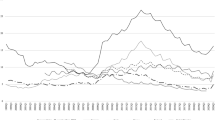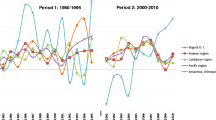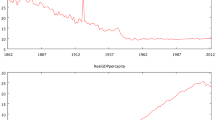Abstract
In many countries it has been established that short-run cyclical patterns in mortality are associated with economic fluctuations. This study aims to investigate the pattern of cyclical mortality in Australia, that is, whether increases or decreases in mortality rates are associated with changes in the economy. Employing logistic fixed-effects models, we show that there is a significant counter-cyclical pattern of mortality (mortality increases during economic contractions) in the general Australian population, over the period 1985–2008. This is an important finding which suggests that steps taken to stimulate the economy during downturns could, apart from other benefits, help reduce the associated increase in mortality. Further analysis by economic growth cycles indicates that the observed counter-cyclical pattern of mortality is significant during phases of expansion but not during contractionary phases.


Similar content being viewed by others
References
Australian Bureau of Statistics. (2010). Australian Bureau of Statistics, Canberra. http://www.abs.gov.au/. Accessed February 2010.
Australian Institute of Health and Welfare. (2010). Australian Institute of Health and Welfare, Canberra. http://www.aihw.gov.au/. Accessed February 2010.
Brenner, M. H. (1971). Economic changes and heart disease mortality. American Journal of Public Health, 61(3), 606–611.
Brenner, M. H. (1973). Mental illness and the economy. Cambridge: Harvard University Press.
Brenner, M. H. (1977). Health costs and benefits of economic policy. International Journal of Health Services, 7(4), 581–623.
Brenner, M. H. (1979). Mortality and the national economy. The Lancet, 314(8142), 568–573.
Brenner, M. H. (1987). Relation of economic change to Swedish health and social well-being, 1950–1980. Social Science and Medicine, 25(2), 183–195.
Brenner, M. H., & Mooney, A. (1983). Unemployment and health in the context of economic change. Social Science and Medicine, 17(16), 1125–1138.
Clark, A. E., & Oswald, A. J. (1994). Unhappiness and unemployment. The Economic Journal, 104(424), 648–659.
Dooley, D., Catalano, R., & Wilson, G. (1994). Depression and unemployment: Panel findings from the epidemiologic catchment area study. American Journal of Community Psychology, 22(6), 745–765.
Dooley, D., Fielding, J., & Levi, L. (1996). Health and unemployment. Annual Review of Public Health, 17(1), 449–465.
Economou, A., Nikolaou, A., & Theodossiou, I. (2008). Are recessions harmful to health after all? Evidence from the European Union. Journal of Economic Studies, 35(5), 368–384.
Edwards, R. (2008). Who is hurt by procyclical mortality? Social Science and Medicine, 67(12), 2051–2058.
Ettner, S. L. (1996). New evidence on the relationship between income and health. Journal of Health Economics, 15(1), 67–85.
Fenwick, R., & Tausig, M. (1994). The macroeconomic context of job stress. Journal of Health and Social Behavior, 35(3), 266–282.
Fontenla, M., Gonzalez, F., & Quast, T. (2009). Are recessions good for everyone’s health? The association between mortality and income by race. Applied Economics Letters, 18, 207–212.
Forbes, J. F., & McGregor, A. (1984). Unemployment and mortality in post-war Scotland. Journal of Health Economics, 3(3), 239–257.
Gerdtham, U.-G., & Johannesson, M. (2004). Absolute income, relative income, income inequality, and mortality. Journal of Human Resources, XXXIX(1), 228–247.
Gerdtham, U.-G., & Johannesson, M. (2005). Business cycles and mortality: Results from Swedish microdata. Social Science and Medicine, 60(1), 205–218.
Gerdtham, U.-G., & Ruhm, C. J. (2006). Deaths rise in good economic times: Evidence from the OECD. Economics & Human Biology, 4(3), 298–316.
Gerlach, K., & Stephan, G. (1996). A paper on unhappiness and unemployment in Germany. Economics Letters, 52(3), 325–330.
Gonzalez, F., & Quast, T. (2010). Macroeconomic changes and mortality in Mexico. Empirical Economics, 40(2), 305–319.
Granados, J. A. T. (2005a). Increasing mortality during the expansions of the US economy, 1900–1996. International Journal of Epidemiology, 34(6), 1194–1202.
Granados, J. A. T. (2005b). Recessions and mortality in Spain, 1980–1997. European Journal of Population, 21(4), 393–422.
Gravelle, H. S., Hutchinson, G., & Stern, J. (1981). Mortality and unemployment: A critique of Brenner’s time-series analysis. The Lancet, 318, 675–679.
Hayes, G. (2008). Mortality and the economy: Is the financial crisis going to kill us?. Canberra: Australian National University.
Hsiao, C. (2003). Analysis of panel data. Cambridge: Cambridge University Press.
Lantz, P. M., House, J. S., Lepkowski, J. M., Williams, D. R., Mero, R. P., & Chen, J. (1998). Socioeconomic factors, health behaviors, and mortality. The Journal of the American Medical Association, 279, 1703–1708.
Laporte, A. (2004). Do economic cycles have a permanent effect on population health? Revisiting the Brenner hypothesis. Health Economics, 13(8), 767–779.
Miller, D. L., Page, M. E., Stevens, A. H., & Filipski, M. (2009). Why are recessions good for your health? American Economic Review, 99(2), 122–127.
Morrell, S., Taylor, R., Quine, S., Kerr, C., & Western, J. (1994). A cohort study of unemployment as a cause of psychological disturbance in Australian youth. Social Science and Medicine, 38(11), 1553–1564.
Neumayer, E. (2004). Recessions lower (some) mortality rates: Evidence from Germany. Social Science and Medicine, 58(6), 1037–1047.
Neumayer, E. (2005). Commentary: The economic business cycle and mortality. International Journal of Epidemiology, 34(6), 1221–1222.
Ogburn, W. F., & Thomas, D. S. (1922). The influence of the business cycle on certain social conditions. Journal of the American Statistical Association, 18(139), 324–340.
Organisation of Economic Co-Operation and Development. (2011). Statistics of Organisation of Economic Co-operation and Development. http://www.stats.oecd.org/. Accessed February 2011.
R Development Core Team. (2011). R: A language and environment for statistical computing, R Foundation for Statistical Computing, Vienna, Austria, ISBN 3-900051-07-0. http://www.R-project.org/
Ruhm, C. J. (2000). Are recessions good for your health? Quarterly Journal of Economics, 115(2), 617–650.
Smith, J. P. (1999). Healthy bodies and thick wallets: The dual relation between health and economic status. The Journal of Economic Perspectives, 13(2), 145–166.
The Melbourne Institute. (2014). Melbourne institute of applied economic and social research, Melbourne. http://www.melbourneinstitute.com/. Accessed December 2014.
Thomas, D. S. (1927). Social aspects of the business cycle. New York: Knopf.
Turner, J. B. (1995). Economic context and the health effects of unemployment. Journal of Health and Social Behavior, 36(3), 213–229.
Wagstaff, A. (1985). Time series analysis of the relationship between unemployment and mortality: A survey of econometric critiques and replications of Brenner’s studies. Social Science and Medicine, 21(9), 985–996.
Wilson, S. H., & Walker, G. M. (1993). Unemployment and health: A review. Public Health, 107(3), 153–162.
Winkelmann, L., & Winkelmann, R. (1998). Why are the unemployed so unhappy? Evidence from panel data. Economica, 65(257), 1–15.
Author information
Authors and Affiliations
Corresponding author
Electronic supplementary material
Below is the link to the electronic supplementary material.
Appendix: Data formulation and issues
Appendix: Data formulation and issues
The data on occurrence of deaths and estimated resident population by sex and state/territory, by 6 monthly intervals for the period 1985–2008, were obtained from the Australian Bureau of Statistics (ABS). The total numbers of deaths in the annual data were calculated by adding the deaths in the two 6 month periods per year. The estimated resident population data were provided from December 1984. In order to calculate the expected exposure to risk, the average population at the beginning and end of each time period was taken. (Note that Northern Territory data is not used in the final analyses because of its relatively large Indigenous population, whose death rates are much higher compared with the rest of the population. Also, the mortality data obtained from the ABS reported a significant number of missing data points in the Northern Territory data.)
Labour statistics by sex and state/territory were obtained from the ABS (catalogue no. 6202.0—Labour Force, Australia). The data were available by month for total unemployed, total labour force and population. In order to calculate the unemployment rate, the data were aggregated to years and then divided by the corresponding aggregate.
The gross domestic product data were also obtained from the ABS (catalogue no. 5206.0—Australian National Accounts: National Income, Expenditure and Product). The data were available quarterly by state (in real terms). The data were aggregated to years by adding the corresponding quarters together. (Note, the data were not available by state/territory for March and June of 1985, so the estimates for the state GDP were calculated by disaggregating the National GDP by the same proportion for each state as in the September and December quarters of 1985, respectively). To obtain the per capita GDP figure, the annual GDP was divided by the population of the state for each time period. (No data for per capita personal income was available for Australia, hence GDP was used as a surrogate. Also, per capita GDP was chosen over average weekly earnings (AWE), as AWE only measures income for employees while GDP measures income for the self-employed, as well as business profits).
The annual data on medical expenditure were obtained from the Australian Institute of Health and Welfare (AIHW). The data were available as a national total for the entire period of study but at a state/territory level only from 1997 onwards. In order to arrive at medical expenditure per person for 1985-1996 the total national medical expenditure from all sources was divided by the corresponding population figure. The resulting value was applied to all the states/territories for the year. From 1997 onwards, the medical expenditure per person was calculated by dividing the total medical expenditure for the state/territory by the population of the state/territory.
The data on the number of people having educational qualifications equal to Year 12 or above were obtained from the ABS (Catalogue no. 6227.0—Education and Work, Australia). Annual data were available for individuals aged between 15 and 64 years of age in the following three groups:
-
1.
2001–2008—by state/territory
-
2.
1996–2000—national level only
-
3.
1985–1995—by sex, national level only
The figures used in the study were obtained by dividing the total number of educated people by the total population in the 15–64 age group (the corresponding population figures for the 15–64 age group were obtained in the original data from the ABS).
In Australia, there is a system of compulsory and free education until age 15 (after which one can join the work force). This is equivalent to a Year 9 level of education. Any education beyond this is optional and hence the inclusion of the educational attainment of Year 12 (age 18 and above) is justified.
Data on the percentage of the population that is Indigenous were obtained from the ABS (catalogue no. 3238.0—Experimental Estimates and Projections, Aboriginal and Torres Strait Islander Australians). The data were available for actual populations for the period 1986–2006 by sex and state. The data for 2007–2008 were obtained by using the estimated population (also provided in the same catalogue using series C). The proportion of the population that is Indigenous was obtained by dividing the total Indigenous population by the total Australian population. (No data were available for 1985 and hence the proportions of 1986 were used as a proxy for 1985).
Finally, the proportions of the population in the following two age groups were calculated:
-
1.
Population below age 5 years (0–4 years)
-
2.
Population above age 64 years (greater than or equal to 65 years)
The percentages were calculated by dividing the population figure in the corresponding age group by the total population in that state or territory and sex for that time period. The resulting figure was used in the final data set.
The study also considered an age group analysis. However, the analysis provided only four significant results out of 45 models considered. Hence the results have not been reported in this paper. However, the results are available in the electronic Supplementary Material.
We primarily used SAS® (Version 9.2) software to process the raw data obtained from the ABS and the AIHW. The resulting dataset was then analysed in the statistical package R (2011) (http://www.R-project.org/). The R-code used in the analyses is provided in the Supplementary Material.
Rights and permissions
About this article
Cite this article
Khemka, G., Roberts, S. Impact of economic cycles on mortality: the Australian context. J Pop Research 32, 139–155 (2015). https://doi.org/10.1007/s12546-015-9146-8
Published:
Issue Date:
DOI: https://doi.org/10.1007/s12546-015-9146-8




